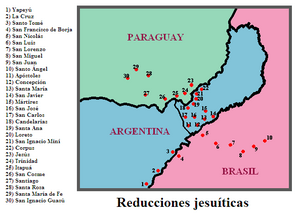Guaraní War facts for kids
Quick facts for kids Guaraní War |
|||||||
|---|---|---|---|---|---|---|---|
 Location of the most important jesuit missions, with current borders |
|||||||
|
|||||||
| Belligerents | |||||||
| Guaraní tribes | |||||||
| Commanders and leaders | |||||||
|
|
||||||
| Strength | |||||||
| 3,000 men | Unknown | ||||||
| Casualties and losses | |||||||
| 4 killed 30 wounded |
1,511 killed 152 captured |
||||||
The Guaraní War (also known as the War of the Seven Reductions) was a conflict that happened from 1754 to 1756. It involved the Guaraní tribes living in seven Jesuit Missions and the combined armies of Spain and Portugal.
This war started because of the Treaty of Madrid signed in 1750. This treaty drew a new border between the lands controlled by Spain and Portugal in South America. The Uruguay River became the new boundary. Portugal gained the land east of this river.
The problem was that seven important Jesuit missions were located east of the Uruguay River. These missions, called the Misiones Orientales, had to be moved to the Spanish side of the river. These missions included San Miguel, Santo Ángel, San Lorenzo Martir, San Nicolás, San Juan Bautista, San Luis Gonzaga, and San Francisco de Borja. Many Guaraní people lived in these missions, with over 26,000 recorded in a Jesuit count.
In 1754, the Jesuits agreed to give up control of the missions. However, the Guaraní people, led by their brave leader Sepé Tiaraju, refused to leave their homes. The Spanish army tried to force them to move in 1754, but they failed.
On February 10, 1756, a large army of 3,000 Spanish and Portuguese soldiers fought the Guaraní at the Battle of Caiboaté. This battle was a terrible defeat for the Guaraní. About 1,511 Guaraní were killed, while the European forces lost only 4 soldiers. After this battle, the Spanish and Portuguese armies took control of the seven missions.
Later, Spain and Portugal decided to cancel the 1750 treaty. This happened with the Treaty of El Pardo (1761). Spain then got back control over the seven missions and the land around them.
Contents
Why the War Started
Jesuit Missions and Borders
Jesuit missionaries from Spain set up the Jesuit missions in the early 1600s. For many years, the Guaraní people in these missions fought against slave hunters from Brazil. These slave hunters, known as bandeirantes, tried to capture the Guaraní to sell them as slaves. The Guaraní also helped Spain fight against Portugal in several colonial wars.
The Treaty of Madrid
The Treaty of Madrid was signed in 1750. Its goal was to end a long-running border dispute between Spain and Portugal in their colonies. Under this treaty, Spain received the outpost of Colonia del Sacramento. In return, the border between the two empires was set along the Uruguay River.
This new border gave a lot of land to Portugal. This land included the seven Jesuit missions where the Guaraní lived. The Guaraní people living in these seven mission settlements did not want to move from their homes. They also refused to live under Portuguese rule. This disagreement led to the Guaraní War.
The War Itself
Early Fights and Leaders
In 1754, Spanish and Portuguese soldiers were sent to force the Guaraní to leave their land. There were many small battles throughout 1754. The Guaraní rebels were led by Sepé Tiaraju. They fought against the combined Portuguese and Spanish forces, which were commanded by Gomes Freire de Andrade. By the end of 1754, a temporary peace agreement was signed between the Guaraní and the European forces.
The Battle of Caiboaté
Fighting started again in 1756. An army of 3,000 soldiers from Spain, Portugal, and their native allies was sent to defeat the Guaraní rebels. This army was led by José de Andonaegui and Freire de Andrade.
On February 7, 1756, Sepé Tiaraju, the brave leader of the Guaraní, was killed in a small fight with Spanish and Portuguese troops. Just three days later, the Guaraní faced a major defeat at the Battle of Caiboaté. In this battle, 1,511 Guaraní were killed, and 152 were taken prisoner. The Spanish and Portuguese forces had very few losses, with only 4 killed and about 30 wounded. After this big defeat, the Spanish and Portuguese armies took control of the Jesuit missions.
What Happened Next
Moving the Guaraní People
After the Guaraní rebels were defeated, the Spanish and Portuguese forced them to leave the seven missions. These missions had been given to Portugal in the Treaty of Madrid. The Guaraní people had to move to lands controlled by Spain.
A count in 1756 showed that the Guaraní population from the seven missions was 14,284. This was about 15,000 fewer people than in 1750. Many had died in the war or moved away.
Changing Borders Again
The former Jesuit missions were occupied by the Portuguese until 1759. In that year, Spain decided to end the Treaty of Madrid on its own. Spain then took back the lands of the seven missions. The final border for the La Plata colonial region was officially set by the Treaty of San Ildefonso in 1777.
See also
 In Spanish: Guerra Guaranítica para niños
In Spanish: Guerra Guaranítica para niños


